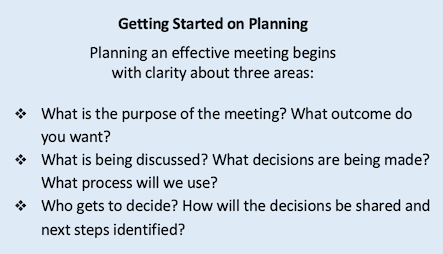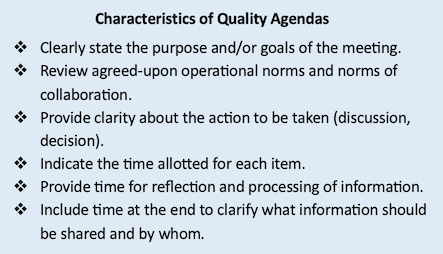You Can Make Meetings More Productive
By Ron Williamson & Barbara Blackburn

Ron Williamson
School leaders spend too much time in meetings. There are meetings with staff, meetings with other principals, meetings with supervisors and meetings with parents. It feels like meetings consume the day. Some meetings we arrange, others we just attend.

Barbara Blackburn
Regardless, you’re likely to think of much of that time as unproductive. This article will discuss ways to make any meeting you plan or attend more productive.
First, one caveat. Only schedule, or hold, a meeting that is thoughtfully planned and implemented. If there is no need for a meeting, or there is nothing of substance on the agenda, give people the gift of time and cancel the meeting. Nothing is worse than a meeting that lacks purpose or for which there is no need.
It Begins With Norms
A crucial part of an effective meeting is having a set of meeting standards or operational norms. This includes basic decisions such as seating arrangements. If you want an open discussion, try to arrange for participants to face each other, perhaps around a table or in a semicircle rather than in rows.
Set firm start and end times, and stick to them. This shows that you respect the participants’ time. If the meeting is lengthy, plan for a break, but again, set a time and adhere to that. Be sure that any speaker knows his or her allocated time and stays within those parameters.
Ask yourself, How will we maintain our group memory about our discussion and decisions? Do you want to use charts posted visibly in the room, or will you have someone record notes? Consider using technology to facilitate meeting discussion or decisions, and post links for participants.
Develop guidelines for discussion. It’s important to embrace a collaborative model for discussion. Allowing adequate wait time in response to questions, asking open-ended questions, and giving everyone a chance to speak are critical elements of a collaborative discussion. (For more tips, see The 7 Norms of Collaborative Work from Thinking Collaborative.)
We often use a “parking lot,” which is simply a poster in the room. Participants are given sticky notes, and if there is a question or discussion item that is off the topic, they write it on a note and post it in the parking lot. You can revisit those items at the end of the meeting if there is time, or you can discuss them individually or at another time.
1. What Is the Purpose of the Meeting?
You may be thinking, “Of course I need to be clear about the purpose. Who doesn’t do that?” But we’ve attended far too many meetings where the purpose was unclear, unstated, or unknown.
Think about it this way: Are you conducting a meeting to discuss and identify options and alternatives for a problem, or is the end result to make a decision? Is this a regularly scheduled meeting like a staff meeting or school improvement team meeting? Are there issues that need discussion and resolution, or is this a meeting to update people on issues?
If you want to bring a group of stakeholders together to gather input, that is appropriate, but if they believe they are meeting to make a decision, then your meeting begins with a conflict, and it is less likely to be productive.
2. What Is Being Decided?
Once the purpose is clear, plan the specific agenda. It’s important for participants to have a clear idea of what will be discussed. If the agenda is to be developed collaboratively, plan for that in advance. An agenda can also help budget time appropriately, so each item is addressed. As you plan, ask yourself, “By the end of the meeting, will participants have the information they need to make a decision on the issue?” You might also consider whether your agenda allows for adequate discussion to inform the decision.
3. Who Makes the Decision?
Prior to the meeting, determine the role of the group in terms of decision making. Is the task of the group to make a decision? Perhaps it is to make a recommendation or to study the issue. Is the decision-making body clear? For example, will the decision be made by the principal alone or by the principal with input?
Perhaps the goal is for the decision to be made by the administrator with staff consensus or by the staff with administrative input. Or the decision may be made by the staff by consensus or by the staff by a majority vote. You may even have a subgroup making the decision. Each of these strategies is appropriate for certain situations. Lack of clarity about decision making leads to misunderstanding and mistrust.
Several years ago while waiting to present a staff development session to elementary school teachers, we observed a principal conducting a short meeting. He explained that a decision needed to be made regarding staffing and personnel responsibilities for the next school year, and that it would be decided based on a vote from teachers and other staff.
Everyone voted on a ballot, and at lunch, the principal privately explained that he was disappointed in the results. He said that he had trusted the staff to make the right decision, and they didn’t. Then he said, “I’m going to tell them that we aren’t doing it that way, we are going to do it my way.” The morale of the teachers and staff plummeted, and the principal lost all credibility. That’s exactly the situation you want to avoid.
As you determine who will make the decision, also consider the timeline for the decision, and make that clear to participants. Finally, determine how the decision will be shared with or communicated to the larger school community.
Productivity Tools
There are a whole set of social media technology tools that you can use to help with meetings. More are developed every day. Here are a few of the social media tools that can support productive meetings.
Calendars – We like Doodle (www.doodle.com) free tools for inviting and responding to meeting invitations.
Collaborate – We’ve found PBWorks (www.pbworks.com) a good site for sharing information and collaborating with others. There is a free option for educators.
Tracking Decisions – It’s easy to add meeting notes to Google Calendar events. Here’s how to do that.
A Final Note
Ultimately, good meetings are interactive and provide for balanced participation. As you plan, find ways to engage every participant in the discussion. In addition to building ownership in the process, your participants will be more productive, and your meetings will be a success.

Dr. Barbara R. Blackburn, a “Top 10 Global Guru in Education,” is a bestselling author of over 30 books and a sought-after consultant. She was an award-winning professor at Winthrop University and has taught students of all ages. In addition to speaking at conferences worldwide, she regularly presents virtual and on-site workshops for teachers and administrators. Barbara is the author of Rigor in Your Classroom: A Toolkit for Teachers, Second Edition (Routledge/EOE, 2023).
Feature image by Gerd Altmann from Pixabay






































